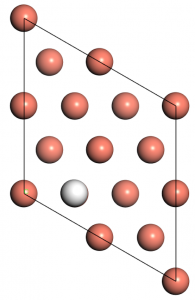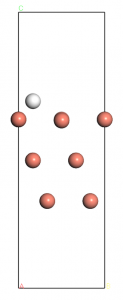1. Problem Description
In this project, the zero point energy (ZPE) correction of one hydrogen atom adsorbed at two different hollow sites of Cu(111) was studied.
In order to get the zero point energy, we firstly initiated the geometry optimization to find the optimal conformation of H adsorbed on Cu(111) as a stating point, by putting the H atom at the fcc-hollow site and hcp-hollow site above the surface for about 2.0 Å. Then, to get the weighted Hessian matrix required to calculate the vibrational frequencies, the H atom was displaced with a step size of 0.05 Å or 0.10 Å along the x, y, and z direction and the corresponding energies were calculated. Different displacements were tested to confirm the correct ZPE. The weighted Hessian matrix consists of the second order derivatives of energies with respect to the displacement along different directions, multiplying the weighted factor. After that, the vibrational frequencies could be found by diagonalizing the Hessian matrix and thus, the ZPE was calculated to correct the binding energy of H at different sites.
2. Computational Method
The surface was cleaved from bulk Cu using Materials Studio along the <111> direction with three layers included. In order to minimize the interactions between periodic images of H atoms, we chose to construct a (2×2) supercell including 10 Å of vacuum space as shown in Figure 1. H atom was initially located at two different hollows site above the surface. During the geometry optimization, the upmost layer along with the H atoms were allowed to move while the bottom two layers were totally fixed at the bulk position. After the geometry optimization, the single point calculations were performed to calculate the energy with different displacement of the H atom.
Figure 1. Top-down view and side view of the Cu(111)-2×2 supercell
All the calculations were carried out using CASTEP with Materials Studio and the GGA-PBE was chosen to be the exchange-correlation functional. The pseudopotential was solved with the Koelling-Harmon atomic solver and the valence electrons were 3d10 4s1 and 1s1 for Cu and H, respectively. The energy cutoff of 408.2 eV and the k-point sampling of 6x6x2 were used. The energy cutoff and k-point sampling were tested to give a convergence within 0.02 eV. The results of convergence tests are summarized below in Table 1. The convergence criteria for force and energy were 0.02 eV/ Å and 10e-6 eV, respectively. The self-consistent dipole correction along the Z-axis was also introduced to better describe the adsorption of the H atom.
| Energy Cutoff (eV) | 400 | 408.2 | 410 | 420 |
| Energy (eV) | -20182.9745 | -20183.1051 | -20183.1281 | -20183.1374 |
| K-point | 5x5x2 | 6x6x2 | 7x7x2 | 8x8x2 |
| Energy (eV) | -20183.0103 | -20183.1051 | -20183.0376 | -20183.1224 |
| Vacuum Space (Å) | 10 | 11 | 12 | 13 |
| Energy (eV) | -20167.1164 | -20167.1163 | -20167.1157 | -20167.1148 |
Table 1: Summary of convergence tests
3. ZPE at FCC-Hollow Site
As the only atom displaced is H in our system, there weighted Hessian matrix can be easily achieved by multiplying a factor to the Hessian matrix. In order to construct the Hessian matrix for vibrational frequency, the H atom should be displaced along the x, y, and z direction with an appropriate step size to calculate the second derivatives of energies with respect the movements.
For the diagonal elements in the Hessian matrix, the second derivative was calculated using three points as shown below in equation 1, while for the off-diagonal elements, it was calculated using four points as in equation 2.
\begin{equation} H_{ii} \cong \frac{E(\delta x_{i})+E(-\delta x_{i})-2E_{0}}{\delta x_{i}^2} \end{equation}
\begin{equation} H_{ij} \cong \frac{E(\delta x_{i}, \delta x_{j})+E(-\delta x_{i},-\delta x_{j})-E(\delta x_{i}, -\delta x_{j})-E(-\delta x_{i}, \delta x_{j})}{4\delta x_{i}\delta x_{j}} \end{equation}
Here, dxi represents the displacement in the i direction (can be along x, y, and z direction) and E0 is the minima energy.
In this project, the step size of 0.05 Å and 0.10 Å were both applied in order to ensure that the displacements were appropriately chosen. Due to the symmetry, there were in total 18 sets of energies of different displacements required and the results for H atom at fcc-hollow site with different step sizes are summarized below in Table 2.
| Displacement Direction | Energy (eV) | |||
| X | Y | Z | Step size = 0.05 Å | Step size = 0.10 Å |
| 0 | 0 | 0 | -20183.1051 | -20183.1051 |
| 1 | 0 | 0 | -20183.1017 | -20183.0910 |
| -1 | 0 | 0 | -20183.1022 | -20183.0943 |
| 1 | 1 | 0 | -20183.0991 | -20183.0829 |
| -1 | -1 | 0 | -20183.0986 | -20183.0773 |
| 1 | -1 | 0 | -20183.0995 | -20183.0841 |
| -1 | 1 | 0 | -20183.0987 | -20183.0779 |
| 1 | 0 | 1 | -20183.0970 | -20183.0760 |
| -1 | 0 | -1 | -20183.0970 | -20183.0704 |
| 1 | 0 | -1 | -20183.0962 | -20183.0647 |
| -1 | 0 | 1 | -20183.0972 | -20183.0777 |
| 0 | 1 | 0 | -20183.1020 | -20183.0929 |
| 0 | -1 | 0 | -20183.1022 | -20183.0933 |
| 0 | 1 | 1 | -20183.0970 | -20183.0767 |
| 0 | -1 | -1 | -20183.0967 | -20183.0678 |
| 0 | 1 | -1 | -20183.0967 | -20183.0857 |
| 0 | -1 | 1 | -20183.0974 | -20183.0684 |
| 0 | 0 | 1 | -20183.0996 | -20183.0848 |
| 0 | 0 | -1 | -20183.1004 | -20183.0776 |
Table 2: Summary of energies with different displacements
According to the equations above, we were able to calculate the elements in the Hessian matrices as well as the eigenvalues these matrices. Thus, the zero point energy can be calculated using the equation 3 and 4 as show below.
\begin{equation} \nu_{i} = \frac{\sqrt{\lambda_{i}}}{2\pi} \end{equation}
\begin{equation} E_{ZPE} = \frac{h\nu_{i}}{2} \end{equation}
Here, vi is the vibrational frequency and lambda is the eigenvalue of the Hessian matrix and h is the Planck’s constant.
For the displacements with step size of 0.05 Å, the weighted Hessian matrix is
\begin{bmatrix} 2.412\times10^{28} & 4.786\times10^{26} & -5.744\times10^{26} \\ 4.786\times10^{26} & 2.297\times10^{28} & 3.829\times10^{26} \\ -5.744\times10^{26} & 3.829\times10^{26} & 3.906\times10^{28}\end{bmatrix}
The eigenvalues are 3.90907327e+28, 2.42876582e+28, and 2.27843185e+28. Corresponding zero point energies are 0.130 eV, 0.102 eV, and 0.099 eV.
For the displacements with step size of 0.10 Å, the weighted Hessian matrix is
\begin{bmatrix} 2.383\times10^{28} & 4.308\times10^{26} & -9.573\times10^{26} \\ 4.308\times10^{26} & 2.297\times10^{28} & 3.590\times10^{26} \\ -9.573\times10^{26} & 3.590\times10^{26} & 3.800\times10^{28}\end{bmatrix}
The eigenvalues are 3.80789093e+28, 2.39781505e+28, and 2.27653408e+28. Corresponding zero point energies are 0.128 eV, 0.102 eV, and 0.099 eV.
We can see that these two different choices bring us similar ZPE with differences less than 2%, which means that our choice of step size of the displacement is appropriate. To sum up, based on the results of 0.10 Å, the total ZPE for H atom at the fcc-hollow site is 0.329 eV. The corresponding eigenvectors are [-0.06640341, -0.91052413, -0.40808872], [0.02181974, -0.41021872, 0.91172611], and [0.99755425, -0.05163733, -0.04710732].
4. ZPE at HCP-Hollow Site
Similarly, we carried out the calculations by initially locating the H atom at the hcp-hollow site. Accordingly, the results for H atom at hcp-hollow site with different step sizes are summarized below in Table 3.
| Displacement Direction | Energy (eV) | |||
| X | Y | Z | Step size = 0.05 Å | Step size = 0.10 Å |
| 0 | 0 | 0 | -20183.0973 | -20183.0973 |
| 1 | 0 | 0 | -20183.0948 | -20183.0874 |
| -1 | 0 | 0 | -20183.0937 | -20183.0830 |
| 1 | 1 | 0 | -20183.0913 | -20183.0708 |
| -1 | -1 | 0 | -20183.0912 | -20183.0753 |
| 1 | -1 | 0 | -20183.0915 | -20183.0718 |
| -1 | 1 | 0 | -20183.0916 | -20183.0766 |
| 1 | 0 | 1 | -20183.0897 | -20183.0703 |
| -1 | 0 | -1 | -20183.0881 | -20183.0560 |
| 1 | 0 | -1 | -20183.0895 | -20183.0631 |
| -1 | 0 | 1 | -20183.0889 | -20183.0678 |
| 0 | 1 | 0 | -20183.0945 | -20183.0859 |
| 0 | -1 | 0 | -20183.0944 | -20183.0857 |
| 0 | 1 | 1 | -20183.0895 | -20183.0697 |
| 0 | -1 | -1 | -20183.0890 | -20183.0607 |
| 0 | 1 | -1 | -20183.0889 | -20183.0602 |
| 0 | -1 | 1 | -20183.0893 | -20183.0692 |
| 0 | 0 | 1 | -20183.0917 | -20183.0768 |
| 0 | 0 | -1 | -20183.0925 | -20183.0774 |
Table 3: Summary of energies with different displacements
For the displacements with step size of 0.05 Å, the weighted Hessian matrix is
\begin{bmatrix} 2.317\times10^{28} & 5.505\times10^{26} & 1.101\times10^{26} \\ 5.505\times10^{26} & 2.202\times10^{28} & -2.393\times10^{26} \\ 1.101\times10^{26} & -2.393\times10^{26} & 3.868\times10^{28}\end{bmatrix}
The eigenvalues of this Hessian matrix are 3.98502936e+28, 2.35385631e+28, and 2.16250165e+28. The corresponding zero point energies are 0.131 eV, 0.101 eV, and 0.097 eV.
For the displacements with step size of 0.10 Å, the weighted Hessian matrix is
\begin{bmatrix} 2.336\times10^{28} & 5.744\times10^{26} & 5.744\times10^{26} \\ 5.744\times10^{26} & 2.183\times10^{28} & 2.872\times10^{26} \\ 5.744\times10^{26} & 2.872\times10^{26} & 3.983\times10^{28}\end{bmatrix}
The eigenvalues of this Hessian matrix are 3.87576398e+28, 2.33336757e+28, and 2.17737216e+28. The corresponding zero point energies are 0.130 eV, 0.101 eV, and 0.097 eV.
We can see that these two different choices bring us similar ZPE with differences less than 2%, which means that our choice of step size of the displacement is appropriate. To sum up, based on the results of 0.10 Å, the total ZPE for H atom at the fcc-hollow site is 0.328 eV. The corresponding eigenvectors are [-0.07002192, -0.91680843, 0.39314022], [0.01196003, -0.39485082, -0.9186674 ], and [-0.99747375, 0.05962489, -0.03861327].
5. Summary
The energies of Cu slab with the H atom adsorbed at different sites before and after ZPE correction are summarized below in Table 4.
| Energy (eV) | ZPE(eV) | Energy with ZPE (eV) | |
| FCC-Hollow | -20183.1051 | 0.3297 | -20182.7754 |
| HCP-Hollow | -20183.0973 | 0.3273 | -20182.7701 |
| Difference | 0.0078 | 0.0024 | 0.0053 |
Table 4. Summary of ZPE at different sites
We can see that ZPE is significant for the H atom adsorbed on Cu(111) but the ZPE at different hollow sites are quite similar. The differences of the total energy with and without ZPE at different sites are both within 0.01 eV, which is very small and the adsorption energy of the H atom at these two sites are almost the same. However, such a small binding energy difference is within the range of convergence error, which means that we cannot decide which site is preferred.
Reference
- Clark, Stewart J., et al. “First principles methods using CASTEP.” Zeitschrift für Kristallographie-Crystalline Materials 220.5/6 (2005): 567-570.
- Perdew, J.P., K. Burke, and M. Ernzerhof, Generalized gradient approximation made simple. Physical review letters, 1996. 77(18): p. 3865.




Hello. Can you share your INPUTS files to do this calculation in VASP? Thank you.